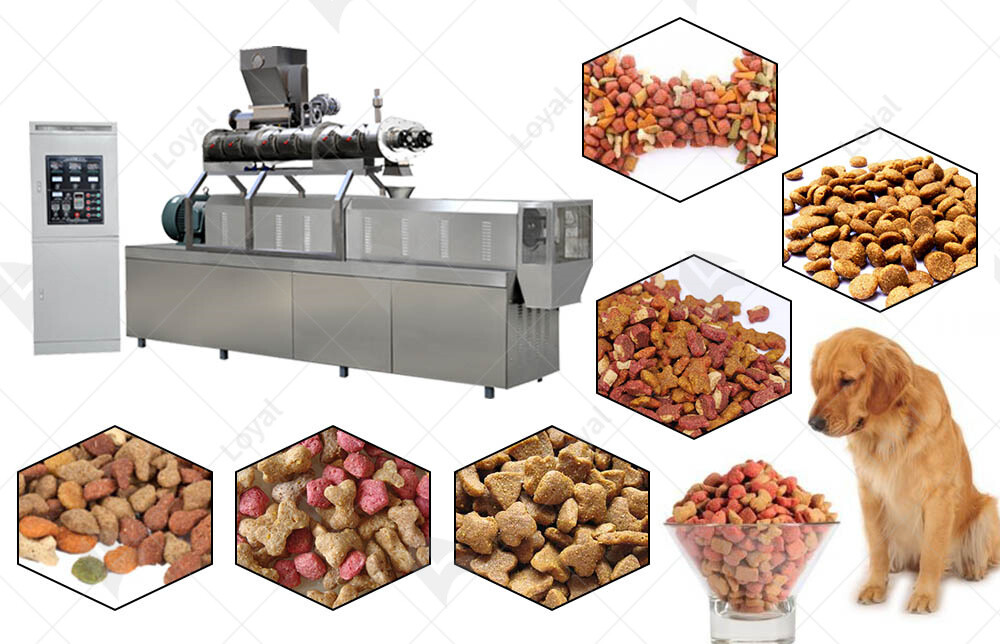Discovering The World Of Dog Food Production Machine
Brief Overview of the Dog Food Manufacturing Industry
The dog food manufacturing industry has seen significant growth in recent years, driven by the increasing popularity of pets and the rising demand for high-quality, nutritious dog food. With pet ownership becoming more mainstream, consumers are becoming more discerning about the ingredients and nutritional value of the food they feed their dogs. This has led to a surge in innovation and competition within the industry, as manufacturers strive to meet the evolving needs and preferences of pet owners.
One of the key factors driving the growth of the dog food manufacturing industry is the increasing demand for convenience. Busy lifestyles have led consumers to seek out convenient, ready-to-eat dog food options that can be easily prepared and served. Additionally, the trend of humanization of pets has also contributed to the rise in demand for premium and gourmet dog food products.
As the industry continues to evolve, dog food production machines have become increasingly important in meeting the demands of manufacturers and consumers alike. Advanced machines are capable of producing a wide range of dog food products, from kibble and canned food to raw and frozen meals, with high levels of precision and efficiency. These machines not only help manufacturers to meet the growing demand for dog food but also enable them to create innovative and customized products that cater to the specific needs and preferences of pet owners.
In the next section, we will explore the differences between traditional dog food production methods and advanced machines, and how the latter have revolutionized the industry.

Traditional Dog Food Production Methods vs. Advanced Machines
Traditionally, dog food production methods were labor-intensive and time-consuming. Manufacturers often relied on manual processes, such as mixing ingredients by hand and shaping the food by pressing it through molds. These methods were not only inefficient but also prone to inconsistencies in quality and nutritional content.
In contrast, advanced dog food production machines have automated many of the processes involved in dog food manufacturing. These machines use cutting-edge technology to mix, shape, and package dog food with high levels of precision and efficiency. The use of automation has not only increased production capacity but also improved the quality and consistency of the final product.
One of the key advantages of advanced machines is their ability to handle a wide range of ingredients, including meats, grains, vegetables, and supplements. These machines can accurately measure and mix these ingredients to create a balanced and nutritious diet for dogs. Additionally, advanced machines can be programmed to produce different shapes and sizes of dog food kibble, catering to the preferences of pet owners and the dietary needs of dogs.
According to Dr. Jane Bicks, a renowned veterinarian and pet nutrition expert, "The advent of advanced dog food production machines has revolutionized the industry, enabling manufacturers to produce high-quality, nutritious dog food that meets the needs of dogs at every stage of their lives. These machines have not only improved the efficiency of production but also allowed manufacturers to create innovative and customized products that cater to the diverse needs and preferences of pet owners."
In the next section, we will delve into the key features of advanced dog food production machines and how they contribute to the success of the dog food manufacturing industry.

Key Features of Advanced Dog Food Production Machines
Advanced dog food production machines are equipped with a range of features that make them ideal for use in the dog food manufacturing industry. Here are some of the key features of these machines:
1.Automation and Precision: Advanced machines are designed to automate many of the processes involved in dog food production, from mixing ingredients to shaping and packaging the final product. This automation reduces the need for manual labor and increases production capacity. Additionally, these machines use precision sensors and controls to ensure that each batch of dog food is produced to the highest standards of quality and consistency.
2.Flexibility and Customization: Advanced machines can be programmed to produce a wide range of dog food products, including kibble, canned food, raw meals, and frozen meals. This flexibility allows manufacturers to cater to the diverse needs and preferences of pet owners. Additionally, machines can be customized to produce different shapes and sizes of kibble, catering to the dietary needs of dogs at every stage of their lives.
3.Ingredient Handling and Nutritional Balance: Advanced machines are equipped with sophisticated ingredient handling systems that can accurately measure and mix a wide range of ingredients, including meats, grains, vegetables, and supplements. These machines use precise controls to ensure that each batch of dog food is formulated to provide a balanced and nutritious diet for dogs.
4.Hygiene and Safety: Advanced machines are designed with hygiene and safety in mind. They use food-grade materials and stainless steel construction to prevent contamination and ensure the safety of the final product. Additionally, machines are equipped with advanced cleaning systems that make it easy to maintain a clean and safe production environment.
In summary, advanced dog food production machines are equipped with a range of features that make them ideal for use in the dog food manufacturing industry. These machines are designed to automate many of the processes involved in production, ensuring high levels of precision and efficiency. Additionally, they offer flexibility and customization options that allow manufacturers to cater to the diverse needs and preferences of pet owners. With these machines, manufacturers can produce high-quality, nutritious dog food that meets the needs of dogs at every stage of their lives.
In the next section, we will explore potential future developments and trends in dog food production machine technology.

Future Developments and Trends in Dog Food Production Machine Technology
As the dog food manufacturing industry continues to evolve, so too does the technology used to produce dog food. Here are some potential future developments and trends in dog food production machine technology:
1.Enhanced Automation and Connectivity: Future dog food production machines may feature even greater levels of automation and connectivity. For example, machines may be equipped with sensors and controls that can monitor and adjust production processes in real-time, ensuring even higher levels of precision and efficiency. Additionally, machines may be connected to the internet, allowing manufacturers to remotely monitor and control production processes from anywhere in the world.
2.Personalization and Customization: As pet owners become increasingly aware of the dietary needs and preferences of their dogs, there may be a growing demand for personalized and customized dog food products. Future dog food production machines may be equipped with advanced technology that allows manufacturers to produce small batches of customized dog food, tailored to the specific needs and preferences of individual dogs.
3.Sustainable and Eco-Friendly Production: With concerns about the environmental impact of food production growing, there may be a trend towards more sustainable and eco-friendly dog food production methods. Future machines may be designed to use less energy and water, and to produce less waste. Additionally, manufacturers may seek to use more sustainable and eco-friendly ingredients in their dog food products.
4.Advanced Ingredient Handling and Nutritional Analysis: Future dog food production machines may feature even more sophisticated ingredient handling systems, allowing manufacturers to accurately measure and mix a wider range of ingredients. Additionally, machines may be equipped with advanced nutritional analysis technology that can analyze the nutritional content of each batch of dog food in real-time, ensuring that it meets the needs of dogs at every stage of their lives.
In summary, the dog food production machine technology industry is likely to continue to evolve in the coming years. Future machines may feature even greater levels of automation and connectivity, allowing manufacturers to produce even higher quality and more customized dog food products. Additionally, there may be a trend towards more sustainable and eco-friendly production methods, as well as advanced ingredient handling and nutritional analysis technology. With these developments, the dog food manufacturing industry is poised to continue to grow and thrive in the future.

Emerging Technologies and Innovations in Dog Food Production
The dog food production industry is constantly evolving, with new technologies and innovations emerging to improve efficiency, quality, and sustainability. Here are some of the latest emerging technologies and innovations in dog food production:
1.3D Printing for Customized Dog Food: 3D printing technology is being explored for use in dog food production, allowing manufacturers to create customized dog food products tailored to the specific needs and preferences of individual dogs. This technology can produce small batches of dog food with precise ingredient proportions, ensuring that each dog receives the perfect blend of nutrients for their unique needs.
2.Blockchain for Traceability and Transparency: Blockchain technology is being used to improve traceability and transparency in dog food production. By recording the journey of each ingredient from farm to factory, blockchain can help manufacturers ensure the quality and safety of their products. Additionally, it can provide consumers with greater transparency about the sources of the ingredients in their dog food.
3.Artificial Intelligence for Quality Control: Artificial intelligence (AI) is being used to improve quality control in dog food production. AI algorithms can analyze data from sensors and other sources to detect potential problems in real-time, allowing manufacturers to quickly address any issues and ensure the quality of their products.
4.Biotechnology for Sustainable Ingredients: Biotechnology is being used to develop sustainable ingredients for dog food production. For example, researchers are working on ways to produce high-quality protein sources from plant-based ingredients using fermentation processes. These plant-based proteins can be used as alternatives to traditional meat-based ingredients, reducing the environmental impact of dog food production.
5.Robotics for Automation and Efficiency: Robotics is playing an increasingly important role in dog food production. Robotic systems can automate tasks such as ingredient handling, mixing, and packaging, improving efficiency and reducing labor costs. Additionally, robots can work in hazardous or difficult-to-reach areas, ensuring the safety of workers.
In summary, the dog food production industry is embracing a range of emerging technologies and innovations to improve efficiency, quality, and sustainability. From 3D printing for customized dog food to blockchain for traceability and transparency, these technologies are poised to revolutionize the way dog food is produced and distributed. As these technologies continue to develop, the dog food manufacturing industry is likely to become even more efficient, sustainable, and responsive to the needs of pet owners.
Reference
The following are five authoritative foreign literature websites in the field of Industrial food machinery:
1. Food Engineering Magazine
Website: https://www.foodengineeringmag.com/
2.Food Processing Magazine
Website: https://www.foodprocessing.com/
3.Journal of Food Engineering
Website:https://www.journals.elsevier.com/journal-of-food-engineering
4. Food Manufacturing Magazine
Website:https://www.foodmanufacturing.com/
5. International Journal of Food Science & Technology
Website:https://onlinelibrary.wiley.com/












